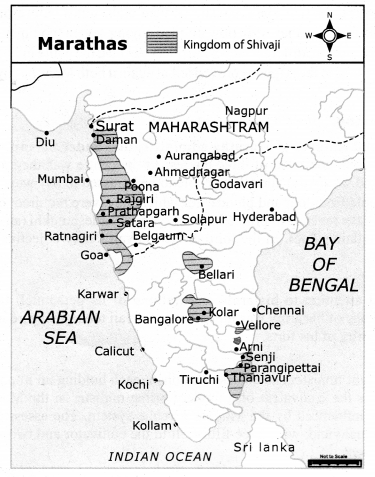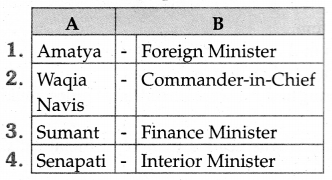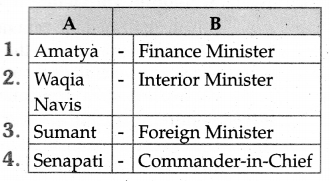You can Download Samacheer Kalvi 7th Social Science Book Solutions Guide Pdf, Tamilnadu State Board help you to revise the complete Syllabus and score more marks in your examinations.
Tamilnadu Samacheer Kalvi 7th Social Science History Solutions Term 2 Chapter 3 Rise of Marathas and Peshwas
Samacheer Kalvi 7th Social Science Rise of Marathas and Peshwas Textual Evaluation
I. Choose the correct answer?
Question 1.
Who was the teacher and guardian of Shivaji?
(a) Dadaji Kondadev
(b) Kavi Kalash
(c) Jijabai
(d) Ramdasl
Answer:
(a) Dadaji Kondadev
Question 2.
How was the Prime Minister of Maratha kings known?
(a) Deshmukh
(b) Peshwa
(c) Panditrao
(d) Patil
Answer:
(b) Peshwa
Question 3.
Name the family priest of Shambhuji who influenced him in his day-to-day administration.
(a) Shahu
(b) Anaji Datta
(c) Dadaji Kondadev
(d) Kavi Kalash
Answer:
(d) Kavi Kalash
Question 4.
What was the backbone of Shivaji’s army in the beginning?
(a) Artillery
(b) Cavalry
(c) Infantry
(d) Elephantry
Answer:
(c) Infantry
Question 5.
Who proclaimed wars and freed Malwa and Gujarat from Mughal domination?
(a) Balaji Vishwanath
(b) Bajirao
(c) Balaji Bajirao
(d) Shahu
Answer:
(b) Bajirao
![]()
II. Fill in the Blanks
- The spread of the _______ movement in Maharashtra helped the Maratha people develop consciousness and oneness.
- _______ was the key official of revenue administration of Peshwa.
- The imperial moment of the Marathas sadly ended at _______ in 1761.
- _______ was the foreign minister in the Ashtapradhan.
- Shambhuji succeeded Shivaji after a succession tussle with _______
Answers:
- Bhakti
- Kamavisdar
- Panipat
- Sumant / Dubeer
- Anaji Dattcu
![]()
III. Match the following
Question 1.
- Shaji Bhonsle – Mother of Shivaji
- Shambhuji – General of Bijapur
- Shahu – Shivaji’s father
- Jijabai – Son of Shivaji
- Afzal khan – Shivaji’s grandson
Answer:
- Shaji Bhonsle – Shivaji’s father
- Shambhuji – Son of Shivaji
- Shahu – Shivaji’s grandson
- Jijabai – Mother of Shivaji
- Afzal khan – General of Bijapur
![]()
IV. True or False
- The rocky and mountainous terrain gave protection to the Marathas from invaders.
- Hymns composed in Sanskrit by the Bhakti saints were sung by people of all castes and classes.
- Shivaji captured Puranthar from the Mughals.
- Deshmukhs held sway over rural regions and their control was over between twenty and hundred villages.
- Abdali invaded ten times before finally marching on Delhi.
Answers:
- True
- False
- True
- True
- False
![]()
V. Consider the following statements. Tick (✓) the appropriate answer
Question 1.
Assertion (A): Soldiers were to live in forts and towns far away from home
Reason (R): Maratha soldiers were not permitted to retire from battlefields each year for the purpose of cultivating their land.
(a) R is the correct explanation of A
(b) R is not the correct explanation of A
(c) A is Wrong and R is correct
(d) A and R are wrong
Answer:
(b) R is not the correct explanation of A
Question 2.
Statement I: Judging from the ledgers of correspondence and account books, Peshwas were keen on accurate record-keeping.
Statement II: Artillery decided the battle at Panipat in 1761.
(a) I is correct
(b) II is correct
(c) I and II are correct
(d) I and II are false
Answer:
(c) I and II are correct
Question 3.
Find the odd one out
Shahji, Shivaji, Shambhuji, Shahu, Rahuji, Bhonsle.
Answer:
Rahuji
Question 4.
Find out the wrong pair
1. Gaikwad – Baroda
2. Peshwa – Nagpur
3. Holkar – Indore
4. Shiride – Gwalior
Answer:
2. Peshwa – Nagpur
Question 5.
Arrange the events in chronological order
(i) Shivaji became totally independent after the death of his guardian Kondadev.
(ii) Emperor Shahu died when Balaji Bajirao was Peshwa.
(iii) Shivaji resumed his military raids after his father’s death and conquered Javali.
(iv) Balaji Vishwanath became Peshwa.
Answer:
(i) Shivaji became totally independent after the death of his guardian Kondadev.
(iii) Shivaji resumed his military raids after his father’s death and conquered Javali.
(iv) Balaji Vishwanath became Peshwa.
(ii) Emperor Shahu died when Balaji Bajirao was Peshwa.
![]()
VI. Answer in one or two sentences
Question 1.
The impact of the Bhakti movement on Marathas.
Answer:
The spread of the Bhakti movement in Maharashtra helped the Maratha people develop consciousness of their identity and oneness. It promoted a feeling of unity, especially in terms of social equality, among the Marathas.
Question 2.
Chauth and Sardeshmukhi
Answer:
Shivaji claimed suzerainty, but he did not administer them himself. He protected the people from loot and plunder for which they were required to pay Chauth (one- fourth of the revenue as protection money) and Sardeshmukhi (an extra one-tenth, as the chieftain’s due).
Question 3.
Role of Kamavisdar in Maratha revenue administration.
Answer:
The revenue administration of Peshwas was headed by a key official called the Kamavisdar. He was appointed by the Peshwa. He was empowered to maintain a small body of soldiers to police the administrative area, from where tribute or tax had to be collected.
Question 4.
Execution of Shambhuji by Mughal Army.
Answer:
Marathas under Shambhuji were in no position to resist the Mughals. Aurangzeb himself arrived in the Deccan in 1681. Aurangzeb’s main goal was the annexation of Bijapur and Golconda. These two sultanates fell to Aurangzeb by 1687. In little over a year, Shambhuji was captured by the Mughals and, after torture, put to death.
Question 5.
Battle of Panipat fought in 1761.
Answer:
The imperial moment of the Marathas sadly ended at Panipat near Delhi in 1761. The king of the Afghans, Ahmad Shah Abdali, invaded eight times before finally marching onto Delhi. The Marathas were now divided among several commanders, who approached the battle with different tactics. Artillery decided the battle in January 1761. The mobile artillery of the Afghans proved lethal against both Maratha cavalry and infantry.
![]()
VII. Answer the following.
Question 1.
Examine the essential features of the Maratha administration under Shivaji.
Answer:
Shivaji’s political system consisted of three circles. At the center was the swaraj. Shivaji was caring and would not allow the people to be harassed in any way.
He protected the people from loot and plunder for which they were required to pay Chauth (one-fourth of the revenue as protection money) and Sardeshmukhi (an extra one-tenth, as the chieftain’s due). In the third circle, Shivaji’s only objective was plunder.
Army
Shivaji gave utmost attention to his army and training of its personnel. In the beginning, the backbone of his army was the infantry. Shivaji took great care in the maintenance and security of his forts.
Ashtapradhan
Shivaji designated eight ministers as the Ashtapradhan, each holding an important portfolio. Peshwa was the equivalent of a modem prime minister in the Maratha Empire. Shivaji was influenced by the Mughal revenue system. The assessments were made on the actual yield, with three-fifths left to the cultivator and two-fifths taken by the government.
![]()
VIII. HOTs
Question 1.
Compare the revenue administration of the Peshwas with that of Shivaji.
Answer:
Revenue administration of Shivaji:
- Shivaji abolished the zamindari system.
- Loans were provided to the farmers in times of famine.
- The state also collected custom duties and professional taxes.
- The two important taxes collected during his time were Chauth and Sardeshmuki.
Revenue administration of Peshwas:
- The revenue administration of pesewas was headed by a key official called the kamavisdar.
- He was empowered to maintain a small body of soldiers to police the administrative area, from where tribute or tax had to be collected.
- A prospective tax or revenue collector who won the contract was expected to have a reputation for wealth and probity.
- He was required to pay a portion of the whole of the anticipated revenue – one third to one half-either out of his own wealth or from the money borrowed from bankers.
![]()
IX. Map
Question 1.
Maratha Empire with prominent cities and forts.
Answer:

![]()
X. Student Activity
Question 1.
Match the responsibilities of Ashtapradhan

Answer:

Question 2.
Group Activity
Collect information about the Thanjavur Marathas with special reference to their contribution to education, art, and architecture.
Answer:
- Venkoji, a half-brother of great Maratha king Shivaji established the Maratha Kingdom at Tanjore in April 1674 A.D.
- Shahuji I, Serfoji I, Serfoji II were important rulers of Tanjore Maratha place, Saraswathi Mahal Library were important buildings built by them.
- They favoured, Sanskrit, and Telugu literature.
- Tanjore paintings are added beauty to their palaces.
![]()
Samacheer Kalvi 7th Social Science Rise of Marathas and Peshwas Additional Questions
I. Choose the correct answer:
Question 1.
_______ language and literature also served to develop unity among the people.
(a) Tamil
(b) Marathi
(c) English
(d) Telugu
Answer:
(b) Marathi
Question 2.
Shivaji became totally independent after the death of his guardian.
(a) Kondadev
(b) Tukaram
(c) Ramdas
(d) Shambhuji
Answer:
(a) Kondadev
Question 3.
_______ captured puranthar from the Mughals.
(a) Shivaji
(b) Shambuji
(c) Shahji Bhonsle
(d) Shahu
Answer:
(a) Shivaji
Question 4.
Shivaji’s political system consisted of ________ circles.
(a) two
(b) three
(c) four
(d) five
Answer:
(b) three
Question 5.
Aurangzeb himself arrived in the Deccan in ________.
(a) 1659
(b) 1663
(c) 1664
(d) 1681
Answer:
(d) 1681
Question 6.
________ now commanded an army of paid soldiers.
(a) Shivaji
(b) Shahu
(c) Balaji Bajirao
(d) Kondadev
Answer:
(c) Balaji Bajirao
![]()
II. Fill in the blanks:
- ________ was a gallant fighter, army general, and guerilla leader.
- ________ promoted a feeling of unity, especially in terms of social equality among the Marathas.
- ________ and ________ had considerable influence on the life of Shivaji.
- In 1659 Shivaji killed ________, a notable general of Bijapur.
- ________ was determined to stop the Maratha interference in his expeditions against the Deccan kingdoms.
- Shivaji designated eight ministers as the ________ each holding an important portfolio.
Answers:
- Shivaji
- Bhakti Movement
- Tukaram, Ramdas
- Afzal khan
- Aurangzeb
- Ashtapradhan
![]()
III. Match the following
- Powerful headman – (a) Mughal revenue system
- Village accountant – (b) Chief Justice
- Shivaji – (c) Foreign Minister
- Nyayadhish – (d) Kulkarni
- Sumant – (e) Patil
Answers:
- – e
- – d
- – a
- – b
- – c
IV. True or False
- The Prime Minister of Maratha rulers called the Peshwas.
- Hymns composed in the Marathi language by Bhakti saints were sung by people of all castes and classes.
- In 1656, the Mughal army was helpless when Shivaji again plundered Suraj.
- Shivaji was influenced by the Mughal revenue system.
- The imperial moment of the Marathas sadly ended at Panipat near Calcutta in 1761.
Answers:
- True
- True
- False
- True
- False
![]()
V. Consider the following statements: Tick the appropriate answer
Question 1.
Assertion (A) : Shambuji succeeded Shivaji after a succession tussle with Anaji Datto.
Reason (R) : Balaji Vishwanath began his career as a small revenue official and became Peshwa in 1713.
(a) R is the correct explanation of A
(b) R is not the correct explanation of A
(c) A is wrong and R is correct
(d) A and R are correct
Answer:
(d) A and R are correct
Question 2.
Statement I : The rocky and mountainous terrain gave protection to the Marathas from invaders.
Statement II : The strength of Shivaji’s army was Mavali foot soldiers.
(a) I is correct
(b) II is correct
(c) I and II are correct
(d) I and II are false
Answer:
(c) I and II are correct
Question 3.
Find out the wrong pair.
1. Panditra – High Priest
2. Nyayadhish – Chief Justice
3. Sacheev – Secretary
4. Peshwa – Finance Minister
Answer:
Peshwa – Finance Minister
![]()
VI. Answer in one or two sentences
Question 1.
Write the geographical features of the Marathas.
Answer:
The physical features of the Maratha country developed certain peculiar qualities among the Marathas, which distinguished them from the rest of the people of India. The rocky and mountainous terrain gave protection to the Marathas from invaders. It proved to be advantageous in guerrilla warfare for Marathas.
Question 2.
Write the literature and language of the Marathas.
Answer:
Marathi language and literature also served to develop unity among the people. Hymns composed in the Marathi language by Bhakti saints were sung by people of all castes and classes.
Question 3.
Write a note on Peshwas.
Answer:
Balaji Vishwanath (1713-1720) began his career as a small revenue official and became Peshwa in 1713. Much against the advice from his close circles, Shahu appointed 20-year-old Viswanath’s eldest son Bajirao to occupy the office of Peshwa.
![]()
VI. Answer the following in detail
Question 1.
Describe Shivaji’s confrontation with the Sultan of Bijapur.
Answer:
- Shivaji became totally independent after the death of his guardian Kondadev (1649).
- He also got his father’s jagir transferred to him, which was earlier looked after by Kondadev.
- The strength of his army was Mavali foot soldiers.
- With their help, Shivaji conquered many of the hill forts near Poona.
- He captured Puranthar from the Mughals.
- Shivaji’s military raids angered the Sultan of Bijapur.
- He held Shivaji’s father captive and released him only after Shivaji promised to suspend his military raids.
- Shivaji kept his word and remained at peace with Bijapur from then on till his father Shahji’s death.
- During this period he toned up his administration.
Question 2.
Briefly explain the consolidation of Maratha Power.
Answer:
- Shivaji resumed his raids after his father’s death and conquered Javali (1656) from the Maratha chief Chandrarao More.
- He also reduced all the lesser Maratha chiefs around Pune to subordination.
- The soldiers of Bijapur from the hill fortresses acquired by the Sultan of Bijapur were driven out and replaced with his own commanders.
- These moves and the defeat of the Bijapur army sent to punish Shivaji alarmed the Mughal officials.
- When the Mughals made a punitive expedition, Shivaj boldly confronted them.
- In 1659 he killed Afzal Khan, a notable general of Bijapur.
- In 1663 he wounded and chased away the Mughal general and Aurangzeb’s uncle Shaista Khan.
- To cap these bold acts, he audaciously directed his soldiers to plunder Surat (1664), the major Mughal port on the Arabian Sea.
![]()
Question 3.
What are the responsibilities of the Asthapradhan?
Answer:
Responsibilities of the Ashtapradhan:
- Pantpradhan / Peshwa – Prime Minister
- Amatya / Mazumdar – Finance Minister
- Shurunavis/Sacheev – Secretary
- Waqia-Navis – Interior Minister
- Sar-i-Naubat / Senapati – Commander-in-Chief
- Sumant / Dubeer – Foreign Minister
- Nyayadhish – Chief Justice
- Panditrao – High Priest
Question 4.
Write about Balaji Bajirao.
Answer:
- When Balaji Bajirao was the Peshwa, Emperor Shahu died (1749).
- He summoned all the contending factions and forced them to accept the conditions he laid down.
- He decided that the capital of the kingdom would henceforward be Pune, not Satara.
- All power and authority were now concentrated in the Peshwas’s office.
- The Maratha peasant warrior band was reconfigured and its run came to an end.
- Maratha soldiers were not permitted now to retire from battlefields each year for the purpose of cultivating their land.
- Soldiers were required to live in forts and towns far away from their homes.
- They were trained as infantrymen as well as horsemen.
- The large guns were nominally under the command of Maratha officers.
- During the period of the Peshwa Balaji Bajirao, the northern frontiers of the Maratha state were rapidly touching Rajasthan, Delhi, and Punjab.
- The Marathas launched raids from Nagpur against Bihar, Bengal, and Odisha. Notwithstanding the conflict between the Marathas and the Nizam over Karnataka, Tamil, Kannada, and Telugu regions were effectively brought under the control of the Marathas.